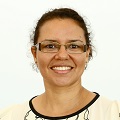
Jaquelyne Hughes is a National Health and Medical Research Council (NHMRC) Early Career Fellow with Menzies School of Health Research, Darwin, Australia, and a clinical nephrologist at Royal Darwin Hospital. Jaqui is a Torres Strait Islander. She completed her PhD on the relationship of body build and body composition with markers of chronic disease in Aboriginal and Torres Strait Islander Australians. Her current clinical workload involves care of people who require dialysis for kidney failure. Her research is directed towards understanding the relationship of body fat (and obesity) with chronic disease. ABSTRACT Markers of Progression of Chronic Kidney Disease: Key findings from the eGFR Study
JT Hughes1, 2, LJ Maple-Brown1, 2
1Division of Medicine, Royal Darwin Hospital, Australia
2Charles Darwin University, Menzies School of Health Research, Darwin, Australia
Rates of end-stage kidney disease (ESKD) are 10-15 times higher among Indigenous Australians compared to the general Australian population, with rates highest in remote regions of Australia. Among Australians with new ESKD in 2010, 76% of Indigenous Australians had type 2 diabetes as a comorbidity, compared to 39% of non-Indigenous Australians. As with other chronic conditions, the age of onset of ESKD in Indigenous Australians is much earlier than in non-Indigenous Australians. The greatest discrepancy in rates of onset of ESKD between Indigenous and non-Indigenous Australians is for those aged 45-54 years.
The eGFR Study is an observational longitudinal cohort study of over 600 Indigenous Australian community-based volunteers across four regions of Australia, selected on the basis of five strata of health, diabetes status and kidney function. Data at baseline included measured glomerular filtration rate (mGFR), and detailed clinical, body composition and biochemical assessment. The primary aim at baseline was to assess the accuracy of equations that estimate GFR in Indigenous Australians. Eligible participants (n=619) were then invited to follow-up at 2-4 years; if unavailable, vital status, progression to renal-replacement therapy and serum creatinine were obtained from medical records.
We reported that the CKD-EPI (Chronic Kidney Disease Epidemiology Collaboration) equation provides a reasonably accurate and un-biased estimate of GFR in this high risk population. Despite known differences in body composition, in 483 Indigenous Australians (with mGFR and bioimpedance measure), fat-free mass did not improve the CKD-EPI equation model estimating GFR. On follow-up of 550 participants (median 3.0 years), baseline and follow-up eGFR (geometric mean, (95% CI)) were 83.9 (80.7, 87.3) and 70.1 (65.9, 74.5) ml/min/1.73m2. Overall mean annual eGFR decline was 3.1 (2.5, 3.6) ml/min/1.73m2. Stratified by baseline eGFR (>90, 60-90, <60), annual eGFR decline was 3.0 (2.4, 3.6), 1.9 (0.5, 3.3), 5.0 (3.6, 6.5) ml/min/1.73m2. Annual eGFR decline was greatest among adults with baseline ACR>30mg/mmol.
In conclusion, the results of The eGFR Follow-Up Study, performed across more than twenty sites in urban, regional and remote regions of Australia, confirm that among high-risk Indigenous Australians populations there is a rapid rate of decline in renal function and that ACR was confirmed as a powerful predictor for eGFR decline across diverse geographical regions.
|
